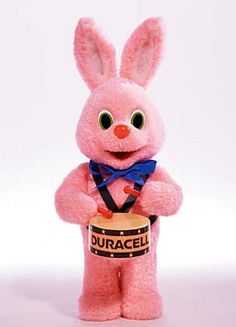The Transatlantic Battery Bunny Battle
Picture a pink bunny rabbit. A toy one, playing a drum. It’s powered by a battery — in fact, it’s the mascot for that battery brand.
Is this what you pictured?

That’s the Energizer Bunny — and if you’re from the United States, that’s almost certainly what sprung to mind. But if you’re from Europe or Australia, you probably pictured the guy below: the Duracell Bunny. And either way, there’s a good chance that you didn’t even know the other one existed.

How does the world get two pink drum-playing battery mascots? It’s a mix of good advertising and bad lawyering.
The Duracell Bunny (which now looks like this and often is seen without a drum) is the older of the two, debuting in 1973. It purports to be a battery-powered toy, one which was intended to demonstrate how much better Duracell batteries were than the competition. That was rooted in science — at the time, the competition had a markedly different product. In the early 1970s, most batteries were zinc-carbon; Duracell, though, popularized the alkaline battery. Duracell wanted to show how their alkaline ones outlasted the zinc-carbon alternatives, so they came up with an ad campaign: a lot of toy pink bunnies playing little drums. One by one, the bunnies collapsed from having run out of juice, leaving only the one with the copper-top Duracell remaining.
The Duracell Bunny ads were popular in Europe (where they mostly aired), and in 1988, Energizer decided to parody them in the United States. The scene was set with a bunch of other toy bunnies, all playing little drums. Then, the Energizer Bunny enters, beating its huge bass drum and swinging his mallet over his head. The other toys all conk out but the Energizer Bunny doesn’t — as the tagline states, this bunny “keeps going and going.” It’s basically the same ad but with a different bunny powered by a different battery.
Despite the slogan, that was supposed to be the end of the line for the copycat Energizer Bunny. But this ad, too, proved quite popular, and Energizer didn’t want to let the successful new mascot go. In total, the Energizer Bunny has appeared in more than 100 commercials since its 1988 debut, becoming one of the nation’s most iconic brand symbols in the process. Energizer had stolen Duracell’s mascot.
And there wasn’t much Duracell could do about it.
It turns out that Duracell, for reasons unclear, did not originally file a trademark application for a “battery bunny” in the United States. Energizer did in 1989, right after its ad debuted; Duracell tried to follow shortly thereafter. But it was too late — Energizer, the U.S. trademark holder, could block that action. That’s basically what they did. According to AdAge, “After Duracell filed for a U.S. trademark on its competing bunny, the two sides reached a largely confidential agreement in 1992 allowing Energizer to use the bunny in the U.S. and Duracell to use it elsewhere.”
There’s been some litigation over the agreement since — most recently in 2016 — but by and large, the two pink bunnies don’t cross paths. As a result, the world is left with two very similar but very popular mascots, and yet, most consumers are only aware of one of them.
Bonus fact: Batteries typically come in AAA, AA, C, and D cell sizes. Where did B go? It’s still around, just used very infrequently to the point that they’re nearly impossible to find. (And the same is true for A.) According to Mental Floss, when consumer battery sizes were standardized in the 1920s, the naming system used was simply: A, B, C, and D. As science developed smaller batteries, we needed more names, but as there’s no letter before A, “AA” and “AAA” were used. The two new smaller battery sizes were popular, crowding A and B out of the market (while C and D batteries “found a niche in medium- and high-drain applications”).
From the Archives: Where the King Dare Not Go: The tale of Burger King and the other Burger King.
